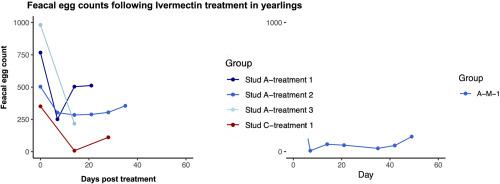International Journal for Parasitology: Drugs and Drug Resistance ( IF 4.1 ) Pub Date : 2023-03-07 , DOI: 10.1016/j.ijpddr.2023.03.001
K E Bull 1 , K J Allen 1 , J E Hodgkinson 2 , L E Peachey 1

|
In recent years, resistance to the benzimidazole (BZ) and tetrahydropyrimidine (PYR) anthelmintics in global cyathostomin populations, has led to reliance on the macrocyclic lactone drugs (ML-of which ivermectin and moxidectin are licensed in horses) to control these parasites. Recently, the first confirmed case of resistance to both ivermectin (IVM) and moxidectin (MOX) was reported in the USA in yearlings imported from Ireland. This suggests that ML resistance in cyathostomins has emerged, and raises the possibility that regular movement of horses may result in rapid spread of ML resistant cyathostomins. Resistance may go undetected due to a lack of surveillance for ML efficacy. Here, we report anthelmintic efficacies in cyathostomins infecting UK Thoroughbreds on four studs. Faecal egg count reduction tests (FECRT) were performed to define resistance (resistance = FECR <95% lower credible interval (LCI) < 90%). Stud A yearlings had FECRs of 36.4–78.6% (CI:15.7–86.3) after three IVM treatments, 72.6% (CI: 50.8–85.2) after MOX, and 80.8% (CI: 61.9–90.0) after PYR. Mares on stud A had a FECR of 97.8% (CI: 93.3–99.9) and 98% (95.1–99.4) after IVM and MOX treatment, respectively. Resistance to MLs was not found in yearlings or mares on studs B, C or D with FECR after MOX OR IVM treatment ranging from 99.8 to 99.9% (95.4–100); although yearlings on studs B, C and D all had an egg reappearance period (ERP) of six weeks for MOX and stud C had a four-week ERP for IVM. This study describes the first confirmed case of resistance to both licensed ML drugs on a UK Thoroughbred stud and highlights the urgent need for a) increased awareness of the threat of ML resistant parasites infecting horses, and b) extensive surveillance of ML efficacy against cyathostomin populations in the UK, to gauge the extent of the problem.
中文翻译:

英国首次报道大环内酯抗性cyathostomins
近年来,全球 cyathostomin 种群对苯并咪唑 (BZ) 和四氢嘧啶 (PYR) 驱虫药产生耐药性,导致依赖大环内酯药物(ML-其中伊维菌素和莫昔菌素在马中获得许可)来控制这些寄生虫。最近,美国报告了第一例从爱尔兰进口的一岁马对伊维菌素 (IVM) 和莫昔菌素 (MOX) 均产生耐药性的确诊病例。这表明 cyathostomins 中的 ML 抗性已经出现,并提出了马的定期运动可能导致 ML 抗性 cyathostomins 快速传播的可能性。由于缺乏对 ML 疗效的监测,耐药性可能未被发现。在这里,我们报告了 cyathostomins 在四个种马上感染英国纯种马的驱虫效果。进行粪便卵数减少试验 (FECRT) 以确定阻力(阻力 = FECR <95% 较低可信区间 (LCI) < 90%)。种马 A 一岁鸽在三次 IVM 处理后的 FECR 为 36.4-78.6% (CI:15.7-86.3),在 MOX 后为 72.6% (CI: 50.8-85.2),在 PYR 后为 80.8% (CI: 61.9-90.0)。种马 A 上的母马在 IVM 和 MOX 处理后的 FECR 分别为 97.8% (CI: 93.3–99.9) 和 98% (95.1–99.4)。在 MOX 或 IVM 处理后 FECR 范围为 99.8 至 99.9% (95.4–100) 的种马 B、C 或 D 的一岁马或母马中未发现对 MLs 的抗性;虽然种马 B、C 和 D 的一岁鸽使用 MOX 的卵子重现期 (ERP) 均为六周,而使用 IVM 的种马 C 的 ERP 为 4 周。































 京公网安备 11010802027423号
京公网安备 11010802027423号